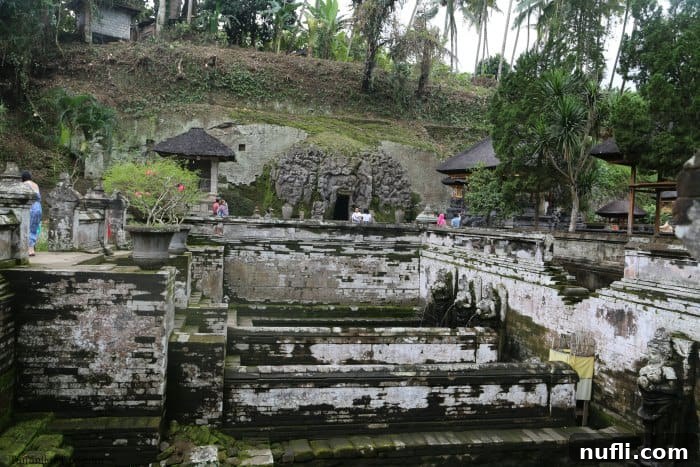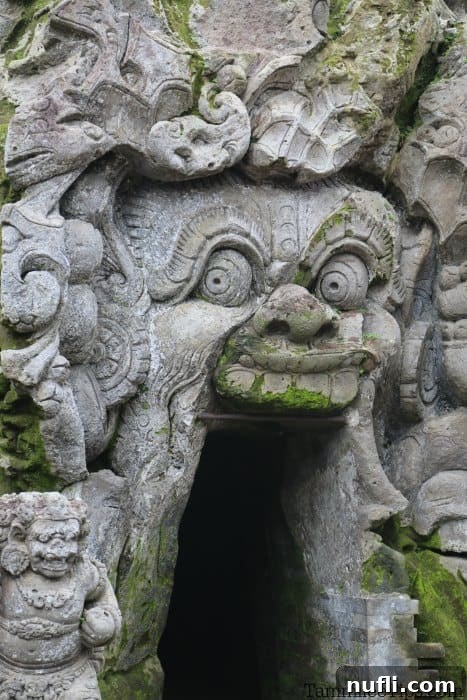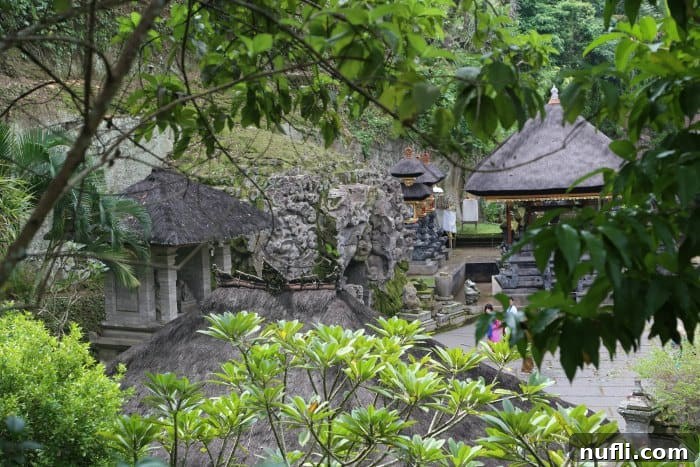Goa Gajah Elephant Cave Bali: Journey into Ancient Spirituality
Embark on a captivating journey to the heart of Bali’s spiritual heritage with a visit to the iconic Goa Gajah, famously known as the Elephant Cave. Nestled amidst lush greenery near Ubud, this ancient archaeological site offers a mesmerizing glimpse into Bali’s rich history, where Hindu and Buddhist influences beautifully converge. Our recent exploration of this revered temple left us in awe of its intricate carvings, mystical chambers, and serene surroundings. Join us as we unveil the secrets and beauty of one of Bali’s most significant cultural treasures.

Before you delve deeper into the wonders of Goa Gajah, planning your Bali adventure is key. Explore top-rated hotels and vacation rentals to find your perfect stay, and consider booking one of the many exciting tours that include this magnificent site.
Discovering the Mystique of Goa Gajah Elephant Cave
Goa Gajah, also known as the Elephant Cave Temple, is far more than just a cave; it’s an extensive archaeological complex that has captivated visitors for centuries. Believed to date back to the 9th or 11th century, this sacred site holds deep historical and spiritual significance for the Balinese people. The name “Goa Gajah” translates to “Elephant Cave,” though the origin of the name is debated. Some believe it refers to the ancient Lwa Gajah River that flows nearby, while others attribute it to the prominent elephant-headed deity, Ganesha, found within its chambers, or perhaps the colossal demon-like entrance resembling an elephant’s head.
As you approach this ancient temple, you are immediately transported to a bygone era. The air hums with a palpable sense of history and spirituality, inviting you to explore its mysteries. Our visit proved to be an unforgettable experience, offering countless opportunities for reflection and breathtaking photography.
The Mystical Entrance: A Glimpse into the Past

The most iconic feature of Goa Gajah is undoubtedly its imposing entrance, carved directly into a rock face. This intricately detailed carving depicts a monstrous, wide-mouthed figure, often identified as a Kala head or a Bhoma figure, an ancient mythological creature believed to protect the sacred space from evil spirits. Its eyes bulge, and sharp fangs are visible, creating a dramatic and somewhat intimidating gateway. Surrounding this central figure are various intricate carvings of leaves, rocks, and mythical animals, reflecting the rich artistic traditions of ancient Bali.
To enter the cave, visitors must pass directly through this gaping mouth, symbolizing a transition from the mundane world into a spiritual realm. This architectural marvel is not merely decorative; it serves as a powerful guardian, setting the tone for the sacred experience within. Before entering any temple in Bali, including Goa Gajah, it’s essential to respect local customs by wearing appropriate attire. This typically means a sarong (a traditional cloth) and a sash around your waist. These are usually available for rent or provided at the main entrance, ensuring all visitors can participate reverently.
For more essential insights and preparation tips for your Balinese adventure, be sure to check out our comprehensive Bali Travel Tips post. It’s packed with valuable information on what to do, see, and how to navigate this incredible island.
Inside the Elephant Cave: A Spiritual Sanctuary

Once you step through the guardian’s mouth, you find yourself within a dimly lit, T-shaped chamber. The atmosphere inside is cool, quiet, and deeply spiritual, a stark contrast to the tropical heat outside. The main chamber houses several significant relics. To the left, you’ll find a shrine dedicated to the Hindu deity Ganesha, the elephant-headed god of wisdom and remover of obstacles, often adorned with fresh offerings by devotees. To the right, a collection of Shivite lingams and yoni, symbols representing the Hindu god Shiva and his consort, illustrate the divine masculine and feminine principles, symbolizing creation and fertility.
Accessing the cave and the lower sections of the complex requires navigating a series of stone steps. While not overly strenuous for most, visitors with mobility concerns, such as knee or back problems, should be aware that there are quite a few steps to descend and later ascend. It’s advisable to take your time, wear comfortable shoes, and enjoy the journey down into this ancient sanctuary. The pathway is well-maintained, but steady footing is always recommended.
The Ancient Bathing Temple and Sacred Springs
Beyond the main cave, the Goa Gajah complex extends into a serene courtyard featuring an ancient bathing temple, known as “Pancuran Goa Gajah.” Discovered in 1954, this excavated bathing area is a marvel of ancient architecture and spiritual significance. The central feature comprises two rectangular pools, fed by water spouting from the breasts of seven exquisitely carved female figures, or Widyadharis (celestial nymphs), holding water vessels. These statues are believed to represent the seven holy rivers of India and are an integral part of purification rituals, where devotees would cleanse themselves before prayer.
The intricate details of these statues, along with the tranquil sound of the flowing water, create a peaceful and contemplative ambiance. This section beautifully exemplifies the site’s role as a place for spiritual purification and communal worship throughout history.
Tracing Buddhist Heritage within Goa Gajah
What makes Goa Gajah particularly unique is its clear evidence of both Hindu and Buddhist influences, signifying a period of religious syncretism in ancient Bali. While the main cave and bathing temple lean heavily into Hindu iconography, excavations around the complex have unearthed relics associated with Buddhism, including small stupas and statues of Buddha. These findings indicate that the site once served as a sanctuary for followers of both faiths, coexisting harmoniously. Exploring these different sections offers a fascinating insight into Bali’s spiritual evolution and its long-standing tradition of religious tolerance.
Exploring the Lush Surroundings and River Valley

The beauty of Goa Gajah extends far beyond its principal structures. The entire complex is enveloped by a verdant, tropical landscape, characteristic of central Bali. Winding paths lead through lush gardens, past tranquil rice paddies, and down to a small river valley. Here, you can discover smaller shrines, ancient rock carvings, and the soothing sounds of nature. It’s an ideal spot for a leisurely stroll, allowing you to absorb the peaceful atmosphere and appreciate the intricate balance between human artistry and the natural world.
Many organized tours offer convenient ways to experience Goa Gajah and other Balinese highlights without the hassle of planning transportation. Explore the full range of options that include the Goa Gajah Temple by clicking HERE.
Essential Tips for Visiting Goa Gajah Elephant Cave
- Best Time to Visit: To avoid the largest crowds and the peak heat of the day, plan your visit in the early morning (shortly after opening) or late afternoon. The lighting is also ideal for photography during these times.
- Dress Code: As with all sacred sites in Bali, a respectful dress code is required. This means covering your shoulders and knees. Sarongs and sashes are provided at the entrance, often included in the admission fee or available for a small rental charge.
- Footwear: Wear comfortable walking shoes, as you’ll be navigating steps and uneven paths within the complex.
- Duration: Allocate at least 1 to 2 hours to fully explore the cave, bathing pools, and the surrounding grounds without feeling rushed.
- Photography: Goa Gajah offers incredible photographic opportunities. Be mindful and respectful of worshippers and avoid flash photography inside the cave if it disturbs others.
- Guided Tours: Consider hiring a local guide at the entrance. Their insights into the history, symbolism, and cultural significance of the site can greatly enrich your experience.
- Stay Hydrated: Bali’s tropical climate can be hot and humid. Carry water with you, especially during your exploration.
- Respect Local Customs: Always be mindful of local customs and traditions. Do not step on offerings placed on the ground, and speak softly in sacred areas.
Why Goa Gajah is a Must-Visit Bali Attraction
Goa Gajah Elephant Cave stands as a powerful testament to Bali’s enduring spiritual legacy. It’s a place where history, art, and nature intertwine, offering a unique and profound cultural experience. From the imposing Kala head entrance to the serene bathing pools and the quiet depths of the T-shaped chamber, every corner of this site tells a story. It provides a rare opportunity to witness the harmonious blend of Hinduism and Buddhism that once flourished on the island, making it a truly exceptional destination for history buffs, spiritual seekers, and anyone looking to immerse themselves in the authentic heart of Bali.
Whether you’re drawn by the allure of ancient mysteries, the beauty of historical architecture, or the tranquility of a sacred space, Goa Gajah promises an enriching and unforgettable visit. It’s not just a temple; it’s a journey through time and faith.
More Bali Adventures Await
Your exploration of Bali’s wonders doesn’t have to end at Goa Gajah. The island is teeming with incredible sites waiting to be discovered. Continue your cultural immersion with these related articles:
- Bali Bat Cave Temple (Pura Goa Lawah)
- Discovering Bali Batik Factory
- Ulun Danu Beratan Lake Temple
- Experiencing the Barong and Kris Dance
- The Serene Tirta Gangga Water Palace
For a comprehensive guide to planning your entire Balinese adventure, be sure to check out all of our Bali Travel Guides. Happy travels!
